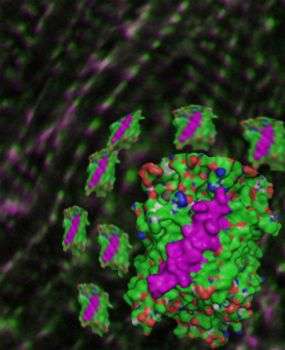A three-dimensional model representing the molecular interaction between the smORF peptides and the calcium pump, superimposed over a microscopy image showing the cellular location of these same proteins in the muscles of an adult fruit fly.
(Phys.org) —A new study by scientists at the University of Sussex shows how the tiny fruit fly could be used to better understand the genetic processes at work in humans, such as those governing heart function.
The study, published today (22 August 2013) in the journal Science Express, describes how, studying fruit flies (Drosophila), researchers have been able to determine the genetic function of a peptide that regulates a calcium pump (called SERCA) in the heart muscles of the fruit fly.
This particular peptide (a chemical compound formed of amino acids) is encoded by a very short sequence of DNA known as a small Open Reading Frame (smORF).
The team then showed that the same smORF, made up of a sequence of just 28 amino acids and already known to regulate muscle contraction of the human heart, has been conserved for more than 500 million years in many animal species – something that has not been shown before.
Professor Juan Couso, who led the study involving a multidisciplinary team made up of members of the University's School of Life Sciences, says: "Our research shows that smORFs can be very ancient and can be conserved in genomes for a long period of time. These smORFs, therefore, must have very important functions, such as regulating heart muscle contractions. We can't keep ignoring smORFs – instead we should study their functions systematically."
The finding is significant because it offers the fruit fly as an easy model to use in the study of the millions of tiny smORFs overlooked in genetic research because of the huge technical challenges in detecting them.
smORFs are putative genes sequences that are 10 to 100 times smaller than the normal genes that we already know about – typically less than 100 amino acids in a chain, and in some known cases as few as 11. A smORF could eventually be used to make a peptide, or it could just be 'junk' DNA – distinguishing between these two possibilities is not easy.
An animal genome typically contains tens of thousands of 'normal' genes, but it also contains hundreds of thousands of smORFs of less than 100 amino acids. Given the huge computational work involved in predicting which of these smORFs are made into peptides and which are not, the prevailing strategy has been to simply ignore them.
There are laboratory techniques that can be used to detect the proteins and peptides produced by genes, but these techniques are more difficult and less successful when applied to smaller genes such as smORFs.
Fruit flies provide an alternative way of studying these smORFs because they breed in big numbers in only 10 days, which means that genetic experiments can be done much more quickly.
Professor Couso says: "The smORF gene in humans, sarcolipin, has been known for a while and its clinical relevance has been well studied. Our study puts forward the fly as a model system to study sarcolipin and SERCA-related heart diseases using genetic techniques that you can't use with humans. For example, the fly could be now used by other researchers to find out which other genes can make SERCA-related arrhythmias better or worse."
The team is looking to expand their research into smORFs from flies to vertebrates – and they already have quite advanced data on another smORF that seems to be also conserved in flies and humans.
More information: Magny, E. et al. Conserved Regulation of Cardiac Calcium Uptake by Peptides Encoded in Small Open Reading Frames, Science Express (22 August 2013). DOI: 10.1126/science.1238802
Journal information: Science Express
Provided by University of Sussex























